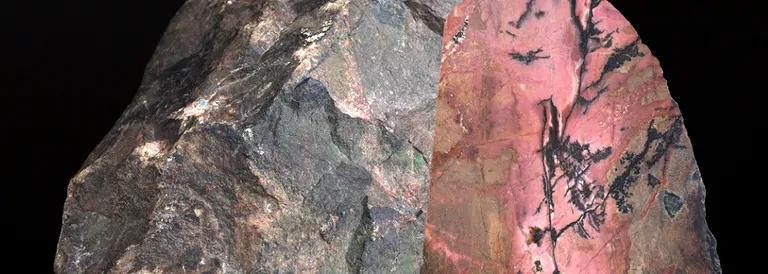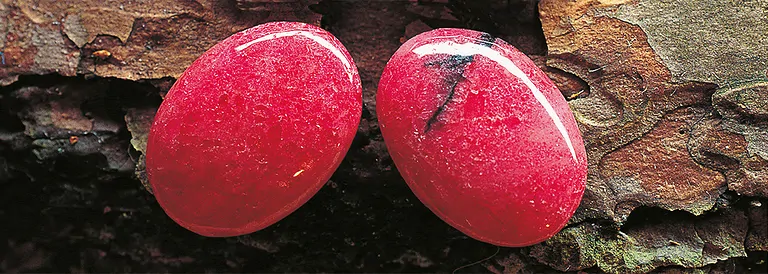
Rhodonite - Bearing and meaning of a pink gemstone
Rhodonite provides with its power for a harmonious end of the year. He brings us forgiveness and reconciliation, so we can leave anger, resentment and negative thoughts with the old year behind us. Conflicts can be solved constructively, because through the Rhodonite we are able to learn from life and what we have experienced during the year. Thus, a way out of (seemingly) hopeless situations becomes possible. With strengthened relationships and friendships, the year ends.
Donuts, drilled stone parts, tumbled stones and more Rhodonite items at wholesale prices
Use and applications of Rhodonite in gemstone healing
No other gemstone than Rhodonite is better suited when it comes to forgive and forgive. Built-up negative feelings let blockages arise, under which we ourselves usually suffer more than the people who were the actual or alleged perpetrators of these burdensome feelings. Negative feelings burden the coexistence. Thus a vicious circle is set in motion, which can lead in the extreme case and on global level up to the emergence of wars.
Forgiveness begins with ourselves! It is shown again and again that it is easier to forgive others than ourselves, even if we are not always aware of it. Here, Rhodonite is a good helper, making us realize that quarrels arise much more often from a lack of self-love than from other people's behavior. The mutual understanding is supported by the Rhodonite, so that forgiveness becomes possible. If you internalize this, conflicts can be solved in a constructive way.
Rhodonite makes it possible to keep a clear head and remain conscious even in extreme situations or under heavy stress. Despite adverse circumstances, it is easier to remain calm and to act with mindfulness.

Donuts, drilled stone parts, tumbled stones and more Rhodonite items at wholesale prices
Mineralogical profile Rhodonite
Chemical formula: CaMn4[Si5O15] + Al, Ba, Cu, Fe, Li, K, Na, S, Zn, coloring metal is manganese
Mineral class: Manganese-calcium mineral of chain silicates
Color: pink, rose red to dark red, brownish, often covered with black crusts of manganese oxide (Psilomelane) or streaked with black veins
Gloss: Vitreous
Crystal system: triclinic
Mohs hardness: 5.5 to 6.5
Cleavability: perfect
Fracture: uneven
Localities: Australia, Brazil, Canada, China, Finland, Russia, India, Japan, Madagascar, Mexico, New Zealand, Romania, Spain, South Africa, Sweden, Switzerland, Tanzania, USA. The raw material for the articles of Rhodonite on the market usually comes from Brazil, China or Peru.
Formation: primary-hydrothermal at low temperatures in gold and silver deposits, tertiary contact metasomatic with manganese-bearing clay sediments or tertiary-regional metamorphic in sedimentary manganese ore deposits.
Type locality: Manganese pit Schävenholz near Elbingerode (Harz, Saxony-Anhalt)
Donuts, drilled stone parts, tumbled stones and more Rhodonite items at wholesale prices
Origin of the name Rhodonite and historical aspects
Rhodonite got its name from the Greek word rhodos (rose) and was so named due to its rose-red coloration in 1819 by the mining and metallurgical plant director Christoph Friedrich Jasche. Synonyms for rhodonite are allagite, hermannite, heteroclinic, horned manganese, kapnikite, manganese amphibole, manganese jasper (impure), manganese silica, pajsbergite, photicite (impure), red amber, red amber ore, red spar, red stone, ruby spar, and tomosite (impure). Fowlerite is a zinc-bearing brownish-yellowish rhodonite, and Hsihusunite is a reddish-purple magnesian rhodonite.
Rhodonite is a popular stone for making arts and crafts and jewelry. In the 19th century, Rhodonite was one of the most popular gemstones in Russia. In the Fersmann Museum in Moscow, there is a 200 kg vase made of pure rhodonite, and in Moscow's Mayakovskaya metro station, entire wall surfaces were lined with rhodonite slabs.

Little sibling of Rhodonite: Psilomelane
The name Psilomelane is derived from the Greek terms "psilos" (smooth, even) and "melas" (black); synonyms are black glass head, hard manganese ore, barun stone and calvonigrite.
Donuts, drilled stone parts, tumbled stones and more Rhodonite items at wholesale prices